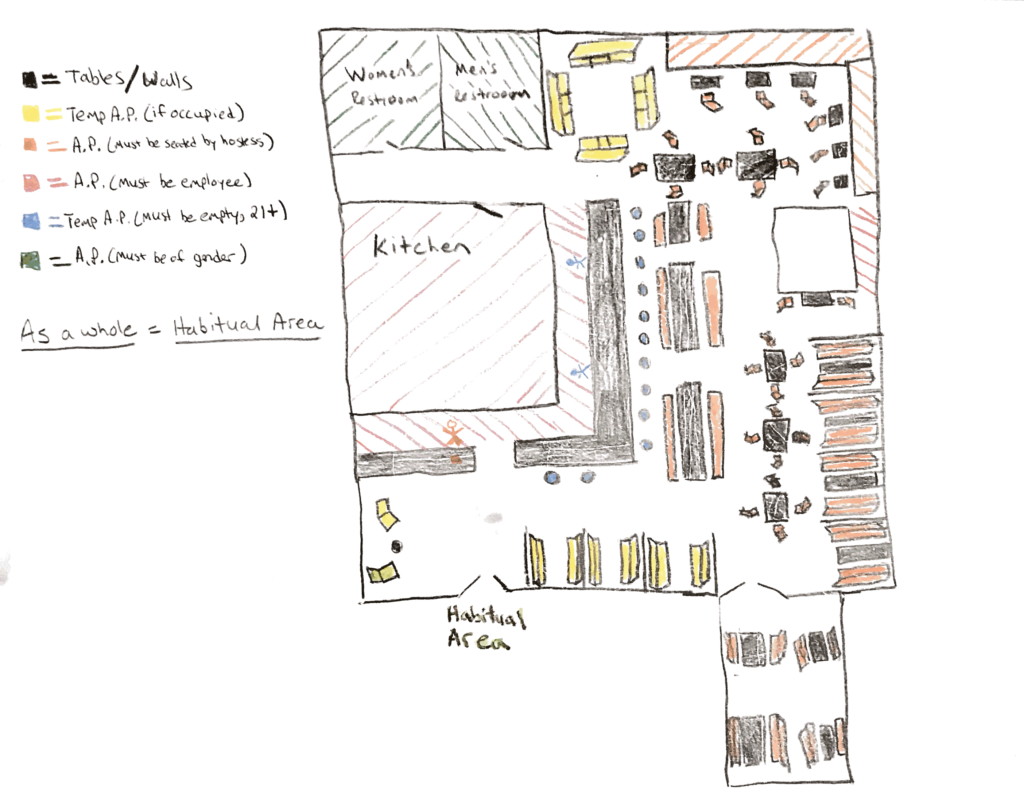..
In this video, you will see people waiting in line to order pizza at a Pizza Port restaurant in Southern California on a busy Friday night in the summer.
The Workout
- 1: Identify the behaviors, gestures, and cues that reveal the man in the grey shirt as being uncomfortable while he waits in line to order a pizza.
- 2: Identify one potential violent or malicious reason for his display of discomfort.
- 3: List the behaviors you would need to observe to lead you to believe that his discomfort reveals a violent intent.
- 4: Identify one potential non-violent or legitimate reason for his display of discomfort.
- 5: List the behaviors your would need to observe to feel confident that his discomfort is not due to him having a violent intent.
- 6: Based on what you observe in this video, identify the option (whether violent or non-violent) that is likely more probable and explain why.
- Write your answers on a sheet of paper before viewing our answers
View Our Answers
1: Identify the behaviors, gestures, and cues that reveal the man in the grey shirt as being uncomfortable.
- Arms crossed
- Swaying back and forth
- Elevated situational awareness
- Shifting weight back and forth
- Rocking side to side to see what is up ahead
- Hands moving around: from hands to hip to rubbing his face, back to crossed
- Minimal conversation with friend
2: Identify one potential violent or malicious reason for his display of discomfort.
- Could be uncomfortable because he is nervous about trying to kidnap the kids in front of him
3: List the behaviors you would need to observe to lead you to believe that his discomfort reveals a violent intent.
- Focused observation of the kid’s father (guy in the blue tee-shirt who replaces the kids in line)
- Focused observation of the kids themselves
- Tracking the kids movement as they move from the line (they go to some video games against the wall)
- Identification of any one else who may be associated with the kids.
4: Identify one potential non-violent or legitimate reason for his display of discomfort.
- Could be uncomfortable because he is waiting in a long line to order and doesn’t know where he will sit once he orders (it is open seating and there is no hostess to assign them a table)
5: List the behaviors your would need to observe to feel confident that his discomfort is not due to him having a violent intent.
- Crowding forward in line to get closer to the point of ordering
- Increased situational awareness to identify potential places where they could sit once he has ordered
- Unfocused situational awareness as he glances at anything that catches his eye
6: Based on what you observe in this video, identify the option (whether violent or non-violent) that is likely more probable and explain why.
- Likely cause: Non-violent – looking for a place to sit
- There is occasional looks at the kids, but not for a prolonged period
- Situational awareness appears to be unfocused as he looks around at multiple tables/groups and isn’t focused on anything specific (like the kids) that he continually comes back to
- Maintains distance and separation from the group ahead of him in line
- His friend (man in black tee-shirt) doesn’t sit down after they talk, but begins looking at the crowded seated area (it is open seating) to see if anything is open, and then returns to stand in a habitual area instead of claiming an anchor point.
Add a comment with the assessments that you made, but that we didn’t make, so that we can check for those assessments and provide feedback on those specific observations. We will add them to our answers in the post itself for future viewings of the exercise.[/expand]
Enhance The Workout
- Repeat
- One of the goals for this exercise is to develop file folders for the uncomfortable cluster and do that in a situation where it is often observed (in long and slow moving lines and where anchor points are not guaranteed).
- So watch and repeat the video as many times as needed to observe and identify each of the uncomfortable cues present.
- For each of the two scenarios being considered (violent and non-violent reasons) continue to watch him and add to the behaviors you would need to see that would lead you to assess either the violent or non-violent causes for his behavior as being more likely.
- Reflect
- A second goal for this exercise is to make a habit of intentionally considering both the violent and non-violent reasons for behavior.
- THIS IS A HUGE COMPONENT TO REMAINING OBJECTIVE IN OUR OBSERVATIONS.
- With the exception of times when it is clear that behavior is displayed at such a high intensity that it requires an immediate decision, we can reduce the amount of uncertainty we face in our decision making by defining each possible options for behavior and actively searching for the information to either confirm or deny our assumptions about the cause.
- The importance of doing this can’t be over-stated.
- Act
- The goal for taking this exercise from the computer to real life is to break domain dependence. Identify an area in your life where you often observe extended lines of people and think about the ways you may have seen people display discomfort in those settings.
- Think about things that the company or whoever controls that area could have done to make people feel more comfortable despite the fact that it is taking a long time to order.
Related Content:

